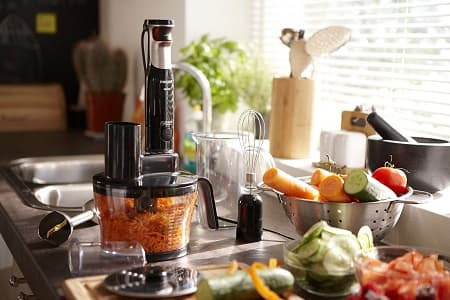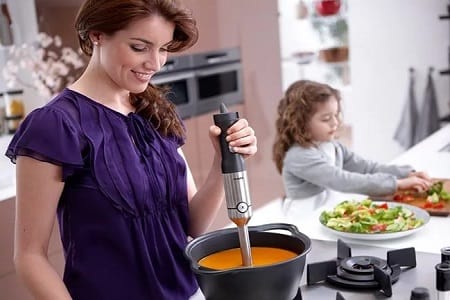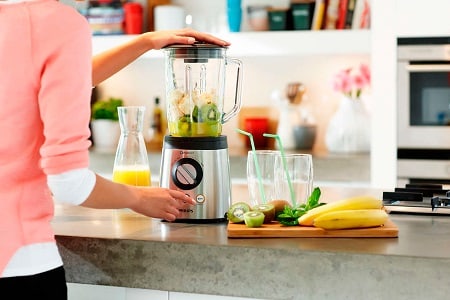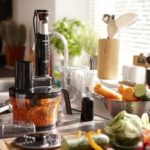People who do not have this device do not understand at all what a blender is for when there is a mixer and a meat grinder. Moreover, they consider it a useless thing. But those who have it simply cannot boast enough!
What is the difference between a blender and other appliances?

Yes, by and large, its function is to grind food. But, he does it in a completely different way than a mixer, meat grinder or food processor! It grinds and whips at the same time, and, moreover, with lightning speed.
If you grind meat in a meat grinder, even with the smallest mesh, the grind will still come out the largest, and the blender simply breaks the food into a homogeneous mass. And due to this, the dishes come out very tender and melt in the mouth, which is especially important for baby food and pates.
And, even if you try to beat the minced meat with a mixer, then absolutely nothing will happen. The mixer will not beat the meat. And washing two appliances is much more energy consuming than one blender!
In addition, as mentioned above, the blender whips very quickly. If you stir with a mixer for ten minutes, then using a blender, it will take one to two minutes. That is, saving time and electricity.
Washing the blender is also much faster than the above-mentioned household appliances. It does not need to be disassembled into many parts. It is enough just to twist the cutting part and simply rinse.
But, for all its merits, it cannot completely replace the meat grinder. You do not always need the result that a blender gives - a homogeneous and pasty consistency. For example, for ordinary cutlets, a meat grinder is much better, since a coarser grind gives more juiciness to the minced meat.
Crush ordinary mashed potatoes, also better by hand, and then beat with a mixer. If you use a blender, then it comes out for some reason sticky and not very tasty. Most likely, the matter is in the composition of the potato itself.
But the mix, from several types of vegetables, comes out just great!
![]() See also - Tips for choosing a blender for your home
See also - Tips for choosing a blender for your home
What types of blenders are there and which one to choose

They are stationary and submersible.
The submersible is made in the form of a handle, with a removable bottom part on which the knives are fixed. After use, the lower part is removed and simply rinsed. Necessarily completed with a small, tall and narrow glass, in which it is very convenient to whip.
Stationary - quite voluminous and looks almost like a combine. It is more difficult to wash it than an immersion one and its only plus is that you do not need to keep it under a canopy.
It costs more than a submersible one, and this gives rise to the illusion that this is a more solid and functional thing. In fact, the opposite is true. Just submersible is more maneuverable, since it can be whipped in any container: even in a glass that comes with the kit, even in a whole saucepan full of soup. And it takes up very little space in the kitchen, and this, you see, is an important factor.
In addition, there are submersible blenders without a cord at all, on the battery. Charge it and use it anywhere.Although, in all honesty, this advantage is very strange and it is not very clear why a battery-powered blender is needed. Where and what needs to be whipped in a place where there is no electricity? Smoothie on the beach or minced meat on the street? But, the fact remains: such models exist and it means that someone needs them.
How to use it correctly
The most important thing is that it should not work longer than 1-2 minutes without turning off. That is, you need to whip, turning it off periodically, since it may simply burn out. This is completely easy to do, since the power button is located on the handle by which you hold the blender.
It is not recommended to immerse it in boiling water. But, here with a caveat: if the immersion (lower) part of the blender is plastic, then it's not worth it, but metal ones are not afraid of high temperatures.
Do not whisk very dry foods without adding liquid, as they will instantly stick to the walls. Nuts, for example, or dried fruits.
For what dishes is a blender indispensable

Here we list a list of dishes that work exceptionally well with this appliance. And nothing else can replace it.
- Homemade mayonnaise
- Liver paste
- Hummus
- Minced meat for the little ones
- Vegetable puree
- Cream soups
- Fish Pastes
- Chile-jam
- Homemade ketchup
- Tkemali
- Dough for pancakes, pancakes, biscuit (any liquid)
- Butter creams for cakes
- Jam, berry jam
- Smoothie
- Milkshake
See, the list is pretty impressive. If there is no blender, then many of the above dishes need to be wiped through a sieve, otherwise, the consistency will not come out as you want. And to wipe it with your hands is not a pleasure for the faint of heart, to be honest. Especially when it comes to large volumes, for conservation, for example.
If you rub at least once through a sieve at least five kilos of berries per jam, then without detailed explanations from our side, it will become very clear to you what a blender is for. To make life easier, that's what!


